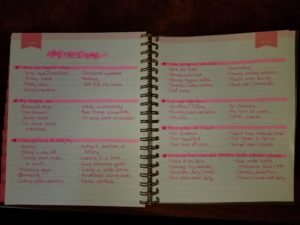Crisis plans, also known as safety plans, are a great tool that allow us to prevent, recognize, prepare for, and respond to a mental health crisis. While it’s always a good time to create a crisis plan, it’s best to tackle it when not in crisis. I have included my personal crisis plan at the end of this article as an example of what this tool looks like for me. Feel free to use it as a guide while crafting your own.
If this is a good time for you, grab a pen and paper (we don’t need anything fancy!) and let’s take a few minutes to think through what happens when we start feeling off balance, what we can do to restore that balance, who are resources to us when we feel unsafe, and how we will respond if crisis takes hold.
i know i’m triggered when…
Emotional triggers are situations, events, things, and sometimes even people, that highly impact our emotions, causing discomfort, distress, or overwhelm. Triggers are unique to each person because they stem from our personal experiences; what elicits an emotional response from one person may not do so for another.
When we know how to identify our triggers ahead of time, we can find creative ways to avoid them and prevent a crisis before it starts.
Think about the last time you felt overwhelmed or anxious. Where were you? How did you feel? How did your body feel? What was your reaction? It’s okay if you need to think about this for a while, especially if you never have before. Some common feelings and symptoms that may come on when triggered include:
- Physical Responses:
- Quickened heartbeat
- Tightness in the chest
- Shaking or nervousness
- Breaking into a sweat
- Feeling tension or pain in different parts of the body
- Sudden headaches or migraines
- Hyperventilating
- Nausea or upset stomach
- Having a hard time sleeping
- Emotional Responses
- Excessive worry
- Irritability and angry outbursts
- Feeling unsafe, afraid, or panicked
- Thoughts of worthlessness, hopelessness, and even suicide
- Flashbacks
- Intrusive thoughts
- Negative self-talk
- Confusion
- Sensory sensitivity (being bothered by things such as bright lights, loud noises, etc.)
Next, let’s name your triggers.
my triggers are…
When enough of these symptoms present themselves, and this could happen all at once or over time, you’ve found your trigger.
Triggers vary greatly; they could be as common as stress, confrontation, embarrassment, new places or people, loud noises, or feeling unheard, or more severe, such as revisiting a place where you experienced trauma or crossing paths with someone who harmed you.
Remember that triggers are very personal, so don’t worry if yours aren’t mentioned here. Write down what your triggers are and let’s move on to the next step.
i can get back to safety by…
Once we have become aware of a trigger, our first priority is getting back to safety.
Take a look at your list of triggers and trigger symptoms – what do you need to feel safe? What do you wish were different when you are in distress? Do you call a friend? Curl up with a pet? Watch your favorite movie or TV show? Do you feel better if you take a walk or go outside? Or maybe you take a long bath? It could be anything that helps center and calm you. Here are some ideas to get your list started:
- Listening to music
- Going somewhere quiet
- Meditating
- Going on a coffee break
- Reading a book
- Taking a bike ride
- Journaling
- Practicing breathing exercises
- Cooking (and enjoying) a good meal
Whatever you do to feel safe, make note of those activities.
i know things are bad when…
Sometimes, even going back to our place of safety just isn’t enough, and our trigger symptoms escalate. However, just like noticing the trigger itself, it’s important to notice when we’re losing control. This could look like:
- Binge eating (or not eating at all)
- Self-harm
- Brain fog or an inability to concentrate
- Poor performance at work or school
- Feeling faint or lightheaded
- Having tunnel vision
- Struggling to stay on top of responsibilities
- Isolating ourselves
- Turning to drugs and alcohol
- Thoughts of suicide
Think about a time you were at the end of your rope and jot down what you felt leading up to that moment. This might stir up a lot of feelings, and it’s okay if you need to take a break and come back to this later. Take as long as you need to to tune into yourself and identify when it’s time to call in for reinforcements.
i can get help from…
If things are getting bad, this is the time to reach out for help. While it’s a great idea to reach out to a therapist or counselor (even before things get bad), getting help can take many shapes – hiring cleaners, asking a friend or family member to help with yard work, or visiting your favorite masseuse for a much-needed massage. Our support systems can be as unique as our triggers, and having a list of who we can go to for help when we need it most can be the difference between finding stability again and spiraling into crisis.
i’m in crisis, so i must…
Being in crisis is a really hard place to be in, which is why we need to know ahead of time how we can best take care of ourselves when times are toughest.
The National Alliance on Mental Illness (NAMI) defines mental health crises as any situation in which a person’s behavior puts them at risk of hurting themselves or others and/or prevents them from being able to care for themselves or function effectively in the community. NAMI has a comprehensive guide that explains what mental illness is, what a mental health crisis looks like, and contains a fillable relapse plan to help you during recovery.
You can also visit our resources page for ideas as you put together your own list of resources to help you when in crisis.
In addition to calling crisis hotlines and text lines, you can also include:
- Getting an urgent appointment with your mental health provider
- Getting some rest
- Eating healthy foods
- Taking time off work
- Telling a trusted loved one that you are in crisis so they can step in to help
The key here is to have immediate access to support so you can get through this time of crisis and begin your recovery.
to recover from crisis and maintain mental wellness i should…
After crisis, recovery can feel like a daunting – sometimes even impossible – task, but it can be made easier by having a go-to list of self-care actions that protect you from future crisis. You could include things like:
- Exercising
- Eating healthy meals
- Drinking enough water
- Practicing personal hygiene
- Attending therapy regularly
- Keeping a clean space
- Getting enough sleep
- Brushing your teeth
- Visiting with friends
- Spending some time outside
Mental Health America also has a great resource with tips and ideas that help in caring for ourselves. Activities listed in this section would ideally be a part of your daily and weekly routines to keep you feeling your best.
Don’t feel limited to this list, either! If there are other activities that make you feel good and keep feelings of overwhelm at bay, be sure to add them and practice them often.
don’t stop now…
Now that you have a good starting point, try adding your own categories. This is your crisis plan, after all. Different types of rest, a specific list of songs or movies, a list of distractions to get you out of your head, and ways you self-soothe (chewing gum, using a fidget toy, or doodling, for instance) could all be included in your crisis plan if you so choose.
You may also want to consider setting up a “mental health emergency fund” for those times when we need to outsource things like dinner and housework, or to pay for self-care activities that come at a cost, like hiring a babysitter, a gym membership, or paying for that monthly mindfulness app subscription. Even setting aside a few dollars a month could allow you to take a coffee break or treat yourself to lunch on a bad day.
Much like the ebb and flow of our lives, our crisis plans will change to meet our needs at any given time, so keep it in a visible location that you access often and don’t forget to keep it updated. I add my crisis plan to my planner at the beginning of each year and revisit my plan mid-year and at times I feel myself veering off track.
Below is a picture of my own crisis plan. I hope it helps you as you develop yours. You can also use this free crisis plan printable to outline a plan that allows you to take care of yourself so you can continue showing up for others.











